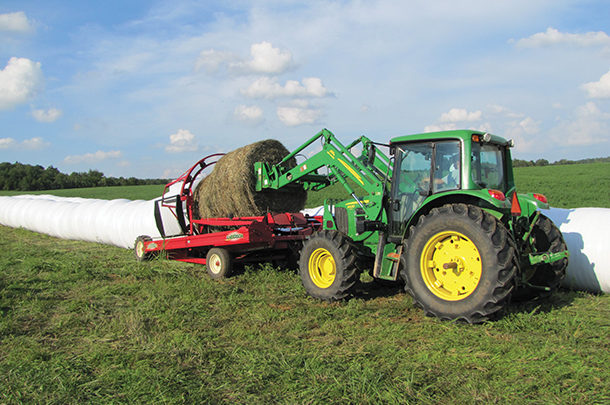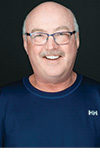When the earliest round balers rolled from the assembly line into the field, hay and straw producers learned these shiny machines were the way of the future. They also learned to be vigilant of bearing fires and permanent neck issues from time spent anticipating the inevitable plugged pickup or twisted belt.
These machines displayed the general shape of today’s models and were either variable (hard-cored) or fixed (soft-cored) but, beyond that, had limited similarities. Extreme versions today might be stationary in the farmyard and filled with a loader tractor or towed beside a moving forage cutter blowing silage into the top hopper compartment. These models can shape a bale and wrap it on the rear of the machine, all while moving or standing still. Other units are equipped with cab or dolly wheels and can be self-propelled between fields at 30 miles per hour.
Adam Verner, owner and operator of Elite Ag in Leesburg, Georgia, has been a fixture in the commercial hay business for 40 years. The fifth-generation mixed farmer and seedstock producer worked in hay and straw operations from southern Georgia, Nebraska, Texas and Oklahoma to northern Minnesota.
Speed, quality and consistent density
Verner says increasing speed in the field and maintaining consistent hay quality are two main objectives for manufacturers servicing the Western and Northern states. Some North American-designed dry models can now reach 12 miles per hour in the field with increased pickup and throat capacity for dry hay and corn materials. But more speed lowers desired density capabilities as tight, dense bales equal reduced pH and sugar contents – indicators of proper fermentation and prolonged forage stability.
“The problem is: Speed is anti-density,” says Verner. “The faster you go, the looser the bales become. It’s a challenge to create more force but still go faster.”
One manufacturer is tackling the issue by adapting attachments used in southern U.S. cotton fields. Cotton yields may vary widely throughout a field, and consistency is elusive. To compensate, a large tub is mounted in the front of the unit, and top and bottom sensors detect the level of the entering cotton. When the level reaches the upper sensor, the baler turns on until the level drops below the bottom sensor. This makes the consistency of the bale more precise. Because of the unpredictable amount of material harvested from hay fields and out of corn combines, this patented technology is in the process of being modified for use with these crops.
Going non-stop with computerization and accessories
Verner likes the idea of self-propelled models and non-stop inclusive machines but sees the market being limited, strictly because of cost. But a spin-off benefit is these units drive automation using tractor implement management (TIM) software systems designed to provide a universal link between balers and tractors.
Equipped non-stop machines complete the entire sequence from beginning the bale to wrapping, opening and closing the chamber, ejection of the bale or completion of plastic application in a combination unit.
“There is still some back and forth with governments and manufacturers about an implement controlling a tractor because it really is telling the tractor when to stop, when to activate what hydraulic and so on. It’s not perfect, but it’s out there and for sale,” Verner says.
New accessories, attachments and features include upgraded drive chains and sprockets, heavier gearboxes and output shafts, and cut-out load limits on clutches to allow higher torque. Ejection bars and moisture test systems can be built in, and plastic wrappers could be added in combination units. Automatic lube stations supply grease and oil directly to where it’s needed, and pickups may now be controlled independently.
“The price of the machines can be up there, especially looking at the combination wrappers, but when you buy them separately, put another operator on a different tractor, for some operators the combos might be a viable option,” Verner says.
Moving from wet to dry
Verner sees a distinct trend in the North American haying industry moving to the use of baleage (relatively high-moisture-content forage) due to shorter production windows and added feed values.
“In the dryer climates of the North and West, it’s harder to put up higher-moisture forage, but it’s coming. Europe has been at this for a long time, and designed models are making their way to the U.S.,” Verner says. He believes there is considerable growth potential in wet hay and silage balers. “The logical step is to go from the dry hay baler, whether it be yellow, red or green, capable of baling wet for a few years, then switching over to a silage-designed machine with suitably positioned rollers and belts, and finally moving to a processing unit with knives.”
In the early 2000s, Adam and his father tested their traditional dry hay machine against a German-designed silage baler to document differences. They ran the two side by side in the same field using the same size of bale and wrap. “We did everything we could to make it the same. In the end, there was an average of 250 more pounds of hay in the silage bales. That’s a lot of pounds.” During the test, only half of the available knives were used, as they worried their cows would make a mess of shorter cut material.
Tests also showed significantly higher relative forage quality (RFQ – estimated digestibility based on filling capacity) and relative feed value (RFV – potential digestible dry matter intake) measurements on the silage bales. “It ensiled better with reduced spoilage, plus the beef cows ate it better and milked better. Their calves even grew better. And because of the extra weight, we used less net wrap and cut our hauling by getting more weight on the trucks,” Verner says.
It is critical operators realistically evaluate and assess their needs when purchasing or upgrading round balers – as accessories, options and features vary. The choices are almost unlimited, but the goal of these units remains the same: quality material wrapped quicker with fewer inputs, preferably without neck cricks and roller bearing fires. ![]()
PHOTO:
Bruce Derksen is a freelance writer based in Lacombe, Alberta.












